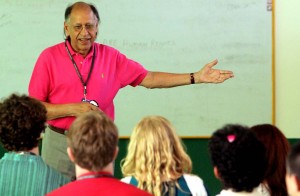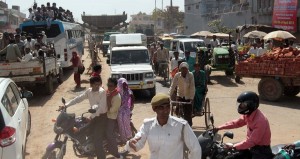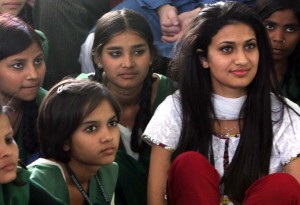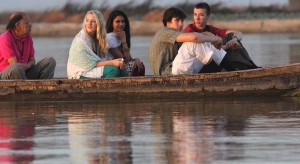

Some say travelling allows us to better examine ourselves. This idea is frequently based on comparing/contrasting our natural situations with more foreign environments. Today while listening to Sam Singh, the founder of the Pardada Pardadi School, a different perspective of this idea was raised. He said that he became more aware of himself while living in the US; because of the questions he was asked. As the only Indian in his peer group, he was seen as the supreme authority on anything Indian. By having to explain the happenings of India whenever something noticeable happened, especially if it was bad, Sam Singh better internalized the problems facing India. Looking at the state of India and his place there inspired him to start the Pardada Pardadi School.
When we travel, no matter the reason for our trip, we represent where we come from. We look at where we come from more thoroughly because we must explain ideas or phenomena that we have a given understanding of to those that don’t. This gives us the opportunity to reexamine our background and our relationship to it and be more aware. Hopefully we can make something from this awareness. It may not always be as obvious as Sam Singh’s example, but looking at how we explain ourselves to outsiders can help us learn more about ourselves.

We make our way through the traffic of Delhi, avoiding motorcycles, rickshaws, vikrams (small motorized tricycle taxis that are often loaded with 8 or 9 people, both inside and on top of it), and other buses. The only law of the road being, size matters; the smaller cars always avoid the bigger. We finally make it out of the densely packed city and into the surrounding grasslands. Crossing over bridges we see the skeletons of dozens of apartment buildings, none of which are finished and all of which have been under construction for years.

Between the unfinished buildings and us, are grass huts with piles of trash around their doors. This creates a shocking contrast between rich and poor that is common across India. Nearby, a beautiful temple to an unknown god interrupts the pattern of apartment buildings and thatch houses. We enter a small town and find that we aren’t the tourists, but rather the attraction. It’s impossible to look out the window and not make eye contact with a stranger. They tap their friends on the shoulder and point at us, not wanting them to miss out on the excitement. We pass through several villages and the reaction is always the same, amazement at the foreigners in their small rural village. Our gaze is only torn away from the side of the road when our bus’s horn sounds and we see a tractor pulling a cart that is stacked 20 feet high with sugar cane. Being the smaller vehicle for once it is our responsibility to avoid the collision, so we swerve on the narrow one and a half lane road, avoiding bicyclists, couples on motorcycles, and cows with carts, in order to pass the slow moving tractor.


We have spent the last couple of days with the most lively, beautiful and smart girls from the Pardada Pardadi School. When we first arrived the founder, Sam Singh, spoke to us about his motivation for starting the school. He told us how each generation of girls is trained by their mothers to collect grass and clean their houses. Most of them come from large families that barely have enough money to eat. The families are struggling to survive rather than teaching their daughters the values they need to learn. At Pardada Pardadi the girls are taught a “values education” and are helped to set goals for after they graduate. They are guaranteed a job after they graduate from high school and help paying for college if they are accepted. Meeting these young women was extremely inspiring. It was wonderful to see the mission of the school in action.

This evening we went for a boat ride on the Ganges. Floating on the river was like being transported back to ancient India. At sunset we approached a bridge that was built four years ago. Previously all traffic had crossed the river by boat. Now tractors loaded to the brink with sugar cane zoomed across the bridge. The juxtaposition of looking at skyscrapers and cement bridges from a wooden boat was striking.

It is amazing to see the contrast between the two sides of India. There are men talking on cellphones while they drive carts pulled by oxen and people who dress the same way their ancestors did thousands of years ago, drinking Coca-Cola. India is a land of fusion where East meets West and old meets new.
Thank you for transporting me to India, if only via my memories of the sounds, sights and smells and your perceptions. Sounds like a great trip thus far and more importantly, wonderful reflections on your part.
Safe journey,
Jivanti
I love reading your posts – even if you don’t see many comments- know that so many of us are keeping up with your travels and experiences. Up at school today the first exchange I heard was ‘has anyone posted on the blog today’?
I have never been to India but enjoy being able to follow you each day. Looking forward to hearing more from all of you at the presentation in April.
Love this! I am reading all of your posts with great interest and so proud of MMS students! Thanks for sharing your experiences.
Wow! I was not only transported to India by reading all of your posts, but also into the hearts and minds of the writers. What an incredible opportunity you have been given, and it is obvious by what we are privileged to read that you are making the most of it. I can’t wait to read more, as it feels like we at home get to be there with you, just a little bit, for a moment. Looking forward to hearing about your next adventure!
Thank you for your insight and wonderful observations, and for transporting me back (almost 20 years!) to the sounds and sights of India. What a lovely experience to float in a wooden boat on the Ganges! The photos capture the very essence of it all – thanks, Shmuel.
My family (Sanika’s) in India are reading your blogs and enjoying seeing India through your eyes. At times, they are so amused by your apt descriptions :). You have all put India into words so vividly and candidly – That which is everyday life to Indians and which we take for granted. I see a common thread among all your observations – How fascinated and amazed you are at the stark contrasts that India shows a visitor – Yes, that is the essence and core of India. Looking forward to your journey every step of the way….
I appreciate your insights as you meet new friends, see new sights – and share these many amazing experiences! Absorb it all!
Thank you all for the wonderful pictures and thoughts about your trip. Speaking for all the parents, we cant get enough! Of course, I love the picture of Karina and Amy with a Cobra. The picture of Sanika with the girls of Pardada Pardati is particularly beautiful. Cant wait to read more tomorrow!
Having fairly recently spent a month in India with Graydon’s mom, Julia, I am really loving your blog posts. You are taking me back to this most fascinating country, filled with such phenomenal contrasts. And, BTW, a very Happy 18th Birthday to Graydon! You’ll never forget this birthday!
Overall it looked like a magnificent trip, seeing the hopefulness and difficulties that make up India. I was particularly pleased by your visit to Pardada Pardadi. I worked with Sam beginning in 2004, helping some of his girls to visit the U.S., and Andrea and I have visited the school several times. I had often thought it would be wonderful to bring Pardada Pardadi and Mt. Madonna together, and am glad to see it has happened.
Richard Sherman
Chevy Chase, MD